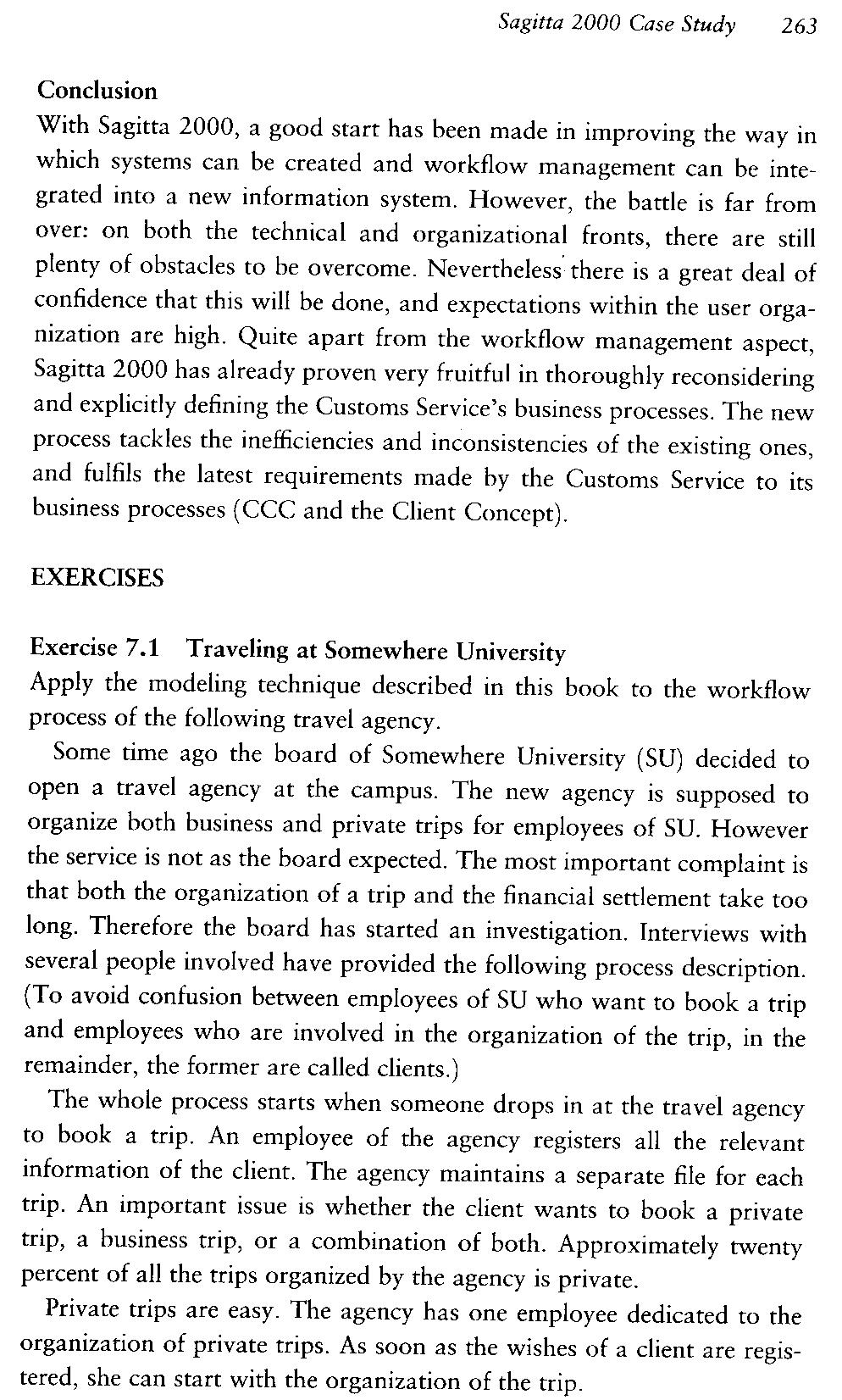39 (120)

Sagitta 2000 Case Study 263
Conclusion
With Sagitta 2000, a good start has been madę in improving the way in which systems can be created and workflow management can be inte-grated into a new information system. However, the battle is far from over: on both the technical and organizational fronts, there are still plenty of obstacles to be overcome. Nevertheless there is a great deal of confidence that this will be done, and expectations within the user orga-nization are high. Quite apart from the workflow management aspect, Sagitta 2000 has already proven very fruitful in thoroughly reconsidering and explicitly defining the Customs Service’s business processes. The new process tackles the inefficiencies and inconsistencies of the existing ones, and fulfils the latest requirements madę by the Customs Service to its business processes (CCC and the Client Concept).
EXERCISES
Exercise 7.1 Traveling at Somewhere University
Apply the modeling technique described in this book to the workflow process of the following travel agency.
Some time ago the board of Somewhere University (SU) decided to open a travel agency at the campus. The new agency is supposed to organize both business and private trips for employees of SU. However the service is not as the board expected. The most important complaint is that both the organization of a trip and the financial settlement take too long. Therefore the board has started an investigation. Interviews with several people invoIved have provided the following process description. (To avoid confusion between employees of SU who want to book a trip and employees who are involved in the organization of the trip, in the remainder, the forrner are called clients.)
The whole process starts when someone drops in at the travel agency to book a trip. An employee of the agency registers all the relevant information of the client. The agency maintains a sępa ratę file for each trip. An important issue is whether the client wants to book a private trip, a business trip, or a combination of both. Approximately twenty percent of all the trips organized by the agency is private.
Private trips are easy. The agency has one employee dedicated to the organization of private trips. As soon as the wishes of a client are regis-tered, she can start with the organization of the trip.
Wyszukiwarka
Podobne podstrony:
00281 ?a198917d25d2fe33d446aa325defc9 283 Experimental Design Models with Random Components has bee
My Britain 2 I m in a mixed-race relationsnip with a white man and it has been really hard. I think
al creatures 19 Flower This flower fairy has been colored in with soft pastel Use two colors an
41 (123) Sagitta 2000 Case Study 265 pricing information. Then the client is called to approve the S
case study in an enierprise). 2. Zastosowanie metod eksploracji danych na wybranym
10 Spis treści 7.3. Case study: rating dla Polski 277 8. Obecny kryzys finans
Mąkinia, J., Wells, S.A., Zima, P. (2005). Temperaturę modeling in activated sludge Systems: a case
Ćwiczenia: S NS ĆwlAnaliza i ocena strategii przedsiębiorstwa - case study. 2 2 Cw2
ćwiczenia - case study Treści merytoryczne przedmiotu: 1. Postępowanie
How to Implement Rabatic Process Autamatian for REGULATION DVI0LATI0N LETTERS in Just 3 Weeks A Case
- HOSPITALITY- 3OI0SS wt: BESquared Hospitality Case Study In September 2012, ESquared Hospitality,
Employee Satisfaction Survey as HRM Audit Method - Case Study Based on X FirmAgata Borowska-Pietrzak
Employee Satisfaction Survey as HRM Audit Method - Case Study Based on X Firm 137 also another persp
Employee Satisfaction Survey as HRM Audit Method - Case Study Based on X Firm
141 Employee Satisfaction Survey as HRM Audit Method - Case Study Based on X Firm and commitment als
Employee Satisfaction Survey as HRM Audit Method - Case Study Based on X Firm 143 Head Office in Pol
więcej podobnych podstron